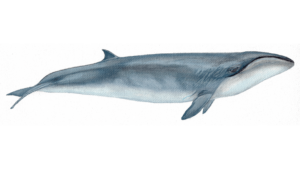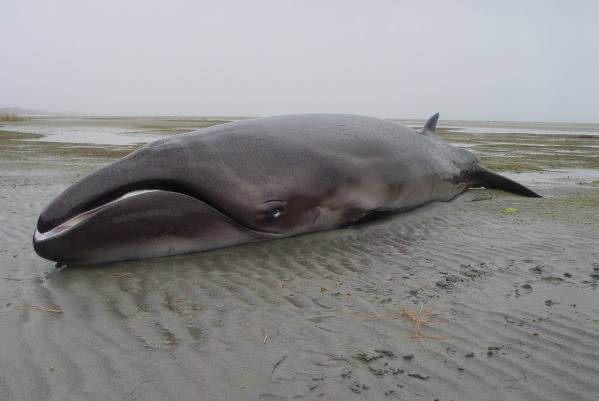The Pygmy Right Whale: Characteristics, Reproduction and Curiosities


Written and verified by the psychologist Sara González Juárez
The cetaceans that inhabit the coldest waters of the planet are, with a few exceptions, largely unknown. This is the case of the pygmy right whale, similar to a whale (in the colloquial sense of the word) but closer to the rorquals. It’s the only survivor of its genus.
These giants of the sea (huge compared to humans, even though their name implies otherwise) deserve much more attention than they’re given. In this article, you’ll find a complete fact sheet on their biological makeup, so don’t miss anything!
Taxonomy and characteristics
The pygmy right whale (Caperea marginata) is a species of mysticete cetacean (i.e. with filtering baleen instead of teeth) belonging to the Cetotheriidae family and the Neobalenids subfamily. Within the latter group there are 2 species, the whale we are dealing with and another extinct that has been extinct since the Miocene, the Miocaperea pulchra.
It is the smallest mysticete at 6.5 meters (21 feet) in length and weighing about 3 tons. It has an elongated, slender body, with a small dorsal fin located in a more caudal position than other species. It has two characteristic grooves on its throat that differentiate it from other whales.
Pygmy right whale habitat
This cetacean is found in a restricted geographic area around the waters of the South Pole. It is also found in a small line that includes the Pacific and Atlantic oceans. It is, therefore, an aquatic and pelagic habitat, with very cold waters.
There are also some small groups in exceptional places, such as Tierra del Fuego and a small region of Tasmania. One study even reported a sighting of a specimen in the northern hemisphere off the coast of Gambia, in Africa.
The pygmy right whale hasn’t been extensively monitored, as sightings are very rare and difficult to track. It’s thought that there are hotspots where zooplankton are abundant and where they come to feed more frequently.
Feeding
Sightings of this cetacean at feeding sites have been scarce. Therefore, most of the information on its diet comes from the analysis of the stomach contents of dead specimens. Like most mysticete whales, it feeds on the krill, small crustaceans, and zooplankton it finds in the water.
By absorbing large quantities of water, the baleen of the pygmy right whale filters the food. After ingesting them, the animal spits out the clean water.
The behavior of the pygmy right whale
If there’s one unknown aspect of this mammal, it’s its behavior. The facts are contradictory, as sightings of groups of them suggest that they move in small family groups. However, the scarcity of encounters with them also leads other authors to claim that they have solitary habits.
We don’t know whether it performs migrations, how it communicates, or whether it establishes relationships with other species. Most of the articles published have to do with exceptional sightings or with their bone structure, which differs markedly from other species of cetacean mysticete.
Reproduction
This is another rather unknown aspect of the pygmy right whale. Each female probably gives birth to a single calf, after what is assumed to be 10-12 months of gestation. This is assumed from other cetacean species of a similar size.
The calves remain with their mother until they’re weaned, which occurs at about 6-12 months of age, depending on the growth rate of the young. Once it begins to eat on its own, the little cetacean will eventually find its own way away from its mother.
Conservation status of the pygmy right whale

As you can imagine at this point, the limited facts we have regarding the pygmy right whale are insufficient to declare an accurate conservation status. Because of this, it has been provisionally placed at the level of Least Concern (LC) on the IUCN Red List.
They aren’t usually hunted by humans, but have ended up as prey a couple of times in the 1970s. Probably the biggest threat these cetaceans face is the same as many others: chance encounters with boats. There have been documented cases of some dying from being stranded, others dying entangled in fishing nets, and others from collisions with boats. Human activity, however, is rather scarce in the areas they frequent, as they are such cold waters.
It isn’t very clear if this lack of information about the pygmy right whale is an impediment to saving them (if they are actually endangered) or a benefit due to them being as far away from humans as they can. So, we simply have to wait and see whether this mysterious being from the frozen oceans will reveal more of its secrets to us in the future.
The cetaceans that inhabit the coldest waters of the planet are, with a few exceptions, largely unknown. This is the case of the pygmy right whale, similar to a whale (in the colloquial sense of the word) but closer to the rorquals. It’s the only survivor of its genus.
These giants of the sea (huge compared to humans, even though their name implies otherwise) deserve much more attention than they’re given. In this article, you’ll find a complete fact sheet on their biological makeup, so don’t miss anything!
Taxonomy and characteristics
The pygmy right whale (Caperea marginata) is a species of mysticete cetacean (i.e. with filtering baleen instead of teeth) belonging to the Cetotheriidae family and the Neobalenids subfamily. Within the latter group there are 2 species, the whale we are dealing with and another extinct that has been extinct since the Miocene, the Miocaperea pulchra.
It is the smallest mysticete at 6.5 meters (21 feet) in length and weighing about 3 tons. It has an elongated, slender body, with a small dorsal fin located in a more caudal position than other species. It has two characteristic grooves on its throat that differentiate it from other whales.
Pygmy right whale habitat
This cetacean is found in a restricted geographic area around the waters of the South Pole. It is also found in a small line that includes the Pacific and Atlantic oceans. It is, therefore, an aquatic and pelagic habitat, with very cold waters.
There are also some small groups in exceptional places, such as Tierra del Fuego and a small region of Tasmania. One study even reported a sighting of a specimen in the northern hemisphere off the coast of Gambia, in Africa.
The pygmy right whale hasn’t been extensively monitored, as sightings are very rare and difficult to track. It’s thought that there are hotspots where zooplankton are abundant and where they come to feed more frequently.
Feeding
Sightings of this cetacean at feeding sites have been scarce. Therefore, most of the information on its diet comes from the analysis of the stomach contents of dead specimens. Like most mysticete whales, it feeds on the krill, small crustaceans, and zooplankton it finds in the water.
By absorbing large quantities of water, the baleen of the pygmy right whale filters the food. After ingesting them, the animal spits out the clean water.
The behavior of the pygmy right whale
If there’s one unknown aspect of this mammal, it’s its behavior. The facts are contradictory, as sightings of groups of them suggest that they move in small family groups. However, the scarcity of encounters with them also leads other authors to claim that they have solitary habits.
We don’t know whether it performs migrations, how it communicates, or whether it establishes relationships with other species. Most of the articles published have to do with exceptional sightings or with their bone structure, which differs markedly from other species of cetacean mysticete.
Reproduction
This is another rather unknown aspect of the pygmy right whale. Each female probably gives birth to a single calf, after what is assumed to be 10-12 months of gestation. This is assumed from other cetacean species of a similar size.
The calves remain with their mother until they’re weaned, which occurs at about 6-12 months of age, depending on the growth rate of the young. Once it begins to eat on its own, the little cetacean will eventually find its own way away from its mother.
Conservation status of the pygmy right whale

As you can imagine at this point, the limited facts we have regarding the pygmy right whale are insufficient to declare an accurate conservation status. Because of this, it has been provisionally placed at the level of Least Concern (LC) on the IUCN Red List.
They aren’t usually hunted by humans, but have ended up as prey a couple of times in the 1970s. Probably the biggest threat these cetaceans face is the same as many others: chance encounters with boats. There have been documented cases of some dying from being stranded, others dying entangled in fishing nets, and others from collisions with boats. Human activity, however, is rather scarce in the areas they frequent, as they are such cold waters.
It isn’t very clear if this lack of information about the pygmy right whale is an impediment to saving them (if they are actually endangered) or a benefit due to them being as far away from humans as they can. So, we simply have to wait and see whether this mysterious being from the frozen oceans will reveal more of its secrets to us in the future.
All cited sources were thoroughly reviewed by our team to ensure their quality, reliability, currency, and validity. The bibliography of this article was considered reliable and of academic or scientific accuracy.
- Cooke, JG 2018. Caperea marginata . La Lista Roja de Especies Amenazadas de la UICN 2018: e.T3778A50351626. https://dx.doi.org/10.2305/IUCN.UK.2018-2.RLTS.T3778A50351626.en . Consultado el 23 de diciembre de 2022 .
- Caperea marginata (pygmy right whale). (s. f.). Animal Diversity Web. https://animaldiversity.org/accounts/Caperea_marginata/
- Tsai, C. H., & Mead, J. G. (2018). Crossing the equator: a northern occurrence of the pygmy right whale. Zoological Letters, 4(1), 1-4.
- Fordyce, R. E., & Marx, F. G. (2013). The pygmy right whale Caperea marginata: the last of the cetotheres. Proceedings of the Royal Society B: Biological Sciences, 280(1753), 20122645.
- Kemper, C. M. (2002). Distribution of the pygmy right whale, Caperea marginata, in the Australasian region. Marine Mammal Science, 18(1), 99-111.
This text is provided for informational purposes only and does not replace consultation with a professional. If in doubt, consult your specialist.








